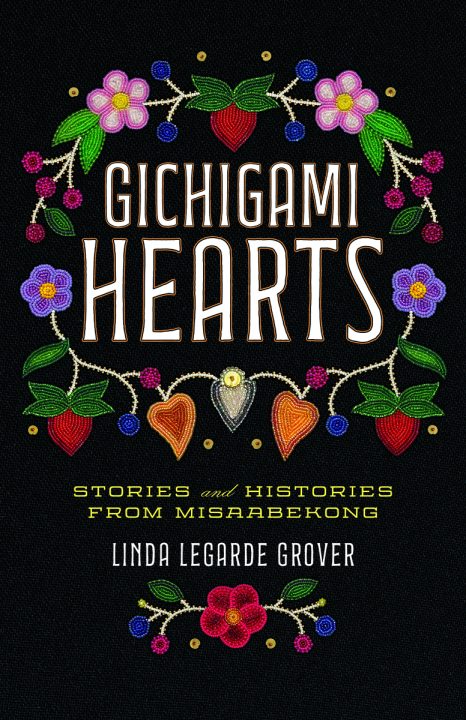
GICHIGAMI HEARTS
Stories and Histories from Misaabekong
Long before there was a Duluth, Minnesota, the massive outcropping that divides the city emerged from the ridge of gabbro rock running along the westward shore of Lake Superior. A great westward migration carried the Ojibwe people to this place, the Point of Rocks. Against this backdrop—Misaabekong, the place of the giants—the lives chronicled in Linda LeGarde Grover’s book unfold, some in myth, some in long-ago times, some in an imagined present, and some in the author’s family history, all with a deep, tenacious bond to the land, one another, and the Ojibwe culture. Within the larger history, Grover tells the story of her ancestors’ arrival in Duluth over two hundred years ago.
Long before there was a Duluth, Minnesota, the massive outcropping that divides the city emerged from the ridge of gabbro rock running along the westward shore of Lake Superior. A great westward migration carried the Ojibwe people to this place, the Point of Rocks. Against this backdrop—Misaabekong, the place of the giants—the lives chronicled in Linda LeGarde Grover’s book unfold, some in myth, some in long-ago times, some in an imagined present, and some in the author’s family history, all with a deep, tenacious bond to the land, one another, and the Ojibwe culture. Within the larger history, Grover tells the story of her ancestors’ arrival in Duluth over two hundred years ago. Blending the seen and unseen, the old and the new, the amusing and the tragic and the hauntingly familiar, this lyrical work encapsulates a way of life forever vibrant at the Point of Rocks.
- University of Minnesota Press
- Paperback
- October 2021
- 200 Pages
- 9781517911935
About Linda LeGarde Grover
Linda LeGarde Grover is professor of American Indian studies at the University of Minnesota Duluth and a member of the Bois Forte Band of Ojibwe. She is author of several award-winning books, including The Road Back to Sweetgrass, Onigamiising: Seasons of an Ojibwe Year, and In the Night of Memory, all from Minnesota, as well as The Dance Boots and The Sky Watched.
Praise
“With compelling stories of sacred places, beloved people, myths, legends, and treasured memories, Gichigami Hearts is a moving tribute to the Ojibwe past.” —Carolyn Holbrook, author of Tell Me Your Names and I Will Testify
“With stories of the essence of land and people, Linda LeGarde Grover weaves a generational history of a sacredness inseparable from place, of the unbroken chain of Anishinaabe existence in Missabekong. Her powerful prose and ethereal poetry wash over the pages like waves along the shore of Lake Superior, revealing a strength of survival that goes beyond memory and reminding us to watch, listen, and breathe.” —Gwen Westerman, Minnesota State University, Mankato
“In Linda LeGarde Grover’s Gichigami Hearts, we are given the gift of an intensely personal, and at the same time brilliant, walkthrough of Grover’s part of the Anishinaabe universe. Just a tremendously lovely and unique book.” —Erika T. Wurth, author of White Horse
“This thoughtful book—parts memoir, history, poetry, myth—presents Duluth and North Shore from the point of view of those who lived there long before white people. Grover, a prizewinning writer and enrolled member of the Bois Forte Band of Ojibwe, brings to vivid life the neighborhoods around Duluth’s Point of Rocks, the town of Chippewa City and places in between.” —Minneapolis Star Tribune
Discussion Questions
- The landscapes and natural surroundings of northeastern Minnesota play key roles in many events described in Gichigami Hearts. In your own experience and as a reader, how does this bring to mind a similar integration of the backdrop of the physical world and that sense of time and place?
- The epigraph in Gichigami Hearts is an excerpt from The Dance Boots, Grover’s 2010 short fiction collection, quoting the fictional Artense Gallette imagining the reuniting of Grover’s grandfather Elias with his true love, Victoria, after death. What might be some examples of love—lost, found, unrequited, reunited—that connect the stories and poems of Gichigami Hearts?
- In reading this collection, we encounter interweavings between Ojibwe traditional beliefs and stories and the history of Duluth and its terrain and landmarks—the Point of Rocks, hills, and Gichigami (Lake Superior). What do you think are some of the reasons this combination has been important to the Ojibwe people of that region?
- What might be some parallels between the niijis (the men who walked the streets of downtown Duluth) and the stories of Nanaboozhoo and his brother Ma’ingen, the wolf?
- The formal schooling education of American Indian children in the Indian boarding school system casts a long shadow over the history of Linda’s family, as well as probably every other Native family in America. What might be some of the ways in which families and family life were affected, and do you think that those effects continue in Native families and communities today?
- In “Life Among the Italians” Grover suggests that the fondness the Italian grandfather had for the LeGarde children may have been because of his general love for children, the LeGarde children’s physical appearance, and that the prejudices the Italian people experienced might have had parallels to those of the Indians. What might some of these experiences have been? Have you heard about or seen similar situations or histories?
- The connections and interactions between Linda and Kate were quite moving to both. Each brought her own facet of her relationship to Elias; what do you think they found and gained from the emails and the afternoon in the coffee shop? Can you identify comparisons and contrasts from the emails, conversations, and the “Traveling Song” chapter that shed light on some of the mysteries and enigmas that were Elias?
- What do you think are some of the complicated legacies that Elias and the other ancestors in Gichigami Hearts left for their descendants and extended families, for the Anishinaabe/Ojibwe people, for all of us?
